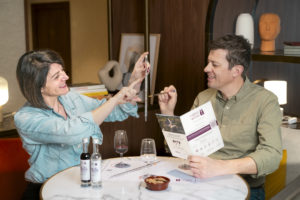Wine blending, also known as “coupage”, is the age-old practice of blending different grape varieties or vintages to create a single wine with harmonious characteristics. This technique is used in major wine-growing regions as well as by small producers to improve the quality, balance and complexity of wines. Here’s an overview of the methods and reasons behind the practice.
Why mix wines?
First of all, we can blend wines for balance and complexity. Indeed, blending allows us to combine the strengths of different grape varieties. For example, one grape variety may bring tannic structure, while another may add fruity or floral aromas. Together, they create a more complex, balanced wine.
Then there’s the consistency. Climatic conditions vary from year to year, affecting the quality of the grapes. Blending different vintages can help maintain a certain consistency in a wine’s taste profile from year to year.
Then there’s wine innovation. It’s not uncommon to see winemakers experimenting with blends to create new wine styles, responding to changing consumer tastes and market trends.
Blending techniques
Cépages blending: This technique involves mixing grapes or wines from different grape varieties. In Bordeaux, for example, Cabernet Sauvignon, Merlot and Cabernet Franc are often blended. Each grape variety brings its own characteristics to the final wine.
Vintage blending: Used mainly for sparkling wines such as Champagne, vintage blending enables wines from different years to be used to achieve consistent quality. Reserve wines are blended with the year’s wines to balance climatic and production variations.
Regional blending: Less common but sometimes used, this type of blending combines wines from different wine-growing regions. This can create unique flavor profiles by combining the specific terroir characteristics of each region.

Stages of the Process
Wine selection: Oenologists select the wines to be blended according to their individual characteristics. Repeated tastings are often necessary to identify wines that complement each other well.
Blending trials: Small samples of each wine are blended in different proportions to test the results. This step is crucial in determining the optimal ratios for the final blend.
Final blending: Once the ideal blend has been found, the wines are combined in large vats. The wine is then aged, often in oak barrels, to allow the flavors to meld and harmonize.
Refining and bottling: After blending, the wine may require a period of refining to reach full maturity before bottling.
An assembly workshop made for you
Would you like to do your own assembly? We’ve found the perfect workshop for you! Discover CréaWine®. CréaWine® is a playful and original oenological experience that allows you to understand the wines that suit you through a wine blending game. During this workshop, you’ll have the chance to meet expert and passionate winemakers. You’ll also have the opportunity to learn how to look, smell and taste wines, before ending up making your own blend. You’ll follow a real tasting session like a professional, and what’s more, you’ll leave with your own blend.
Book your workshop on lowine.fr or buy your home workshop on creawine.com !
It’s all you need to spend a convivial moment together.

In conclusion, we can say that blending wines is a true art form that requires an in-depth knowledge of grape varieties, terroirs and winemaking techniques. Whether to create a more balanced wine, to maintain consistency from year to year, or to innovate with new flavors, blending remains an essential practice in the wine world. For wine lovers, it’s a guarantee of discovering wines of character and superior quality, reflecting the know-how and creativity of our winemakers.



